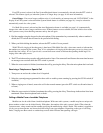However, if a function is controlled by an option switch or the Menu mode, it returns to the condition that was
selected by those features. The functions that can be programmed in the profile are as follows. Descriptions of these
features start on page 18.
Auto-Registration Scan Type Select
Auxiliary 1 and 2 Priority
Backlight Radio Sounds
Bank Select Scan List Save Mode
View Angle Adjust LTR System Search
Encryption Talk-Around
External PA Telephone Number
Horn/Light Status
Emergency Switch
The emergency option switch is used to set up a high-priority call. If this switch is programmed, it is the switch on
the left side of the display. An external switch, such as a foot-operated type, may also be used. With Multi-Net systems,
either manual or automatic operation is available; with LTR and conventional systems, only manual operation is avail-
able.
When manual operation is programmed, a specific system/group is selected and the transceiver goes into a high-
priority access mode. However, no call is placed automatically. This access mode minimizes, as much as possible, the
chance that the system will be busy when the call is placed.
When automatic operation is programmed, the transceiver automatically transmits an emergency message on the
emergency system/group. This message is transmitted at the highest priority until an acknowledgment is received from
the dispatcher. If you have the emergency switch feature, your system operator will provide additional information on
how to use it.
Power Turn-Off Delay
The transceiver can be programmed so that the vehicle ignition switch as well as the front-panel power switch
controls transceiver power. In addition, delays of 10 or 30 minutes, or 1, 8, 10, or 12 hours or infinite (no turn-off) can
be programmed. The delay can be canceled at any time by turning power off using the front-panel switch or turning the
ignition switch back on.
A delay allows features such as the horn alert and call indicator to remain active for a time after the vehicle is
turned off. At the same time, advantages of ignition switch control can be utilized such as preventing battery discharge
that may occur if the transceiver is accidentally left on for an extended period (see “Preventing Battery Discharge” on
page 26).
MULTI-NET FEATURES
Busy Queuing
The Busy Queuing feature places the call in queue if the system is busy when the PTT switch is pressed. Then
when the system becomes available, a tone sounds and the call can be placed if desired. This feature is available if it has
been enabled by programming, and it functions with all types of Multi-Net calls. Busy queuing operates as follows:


















